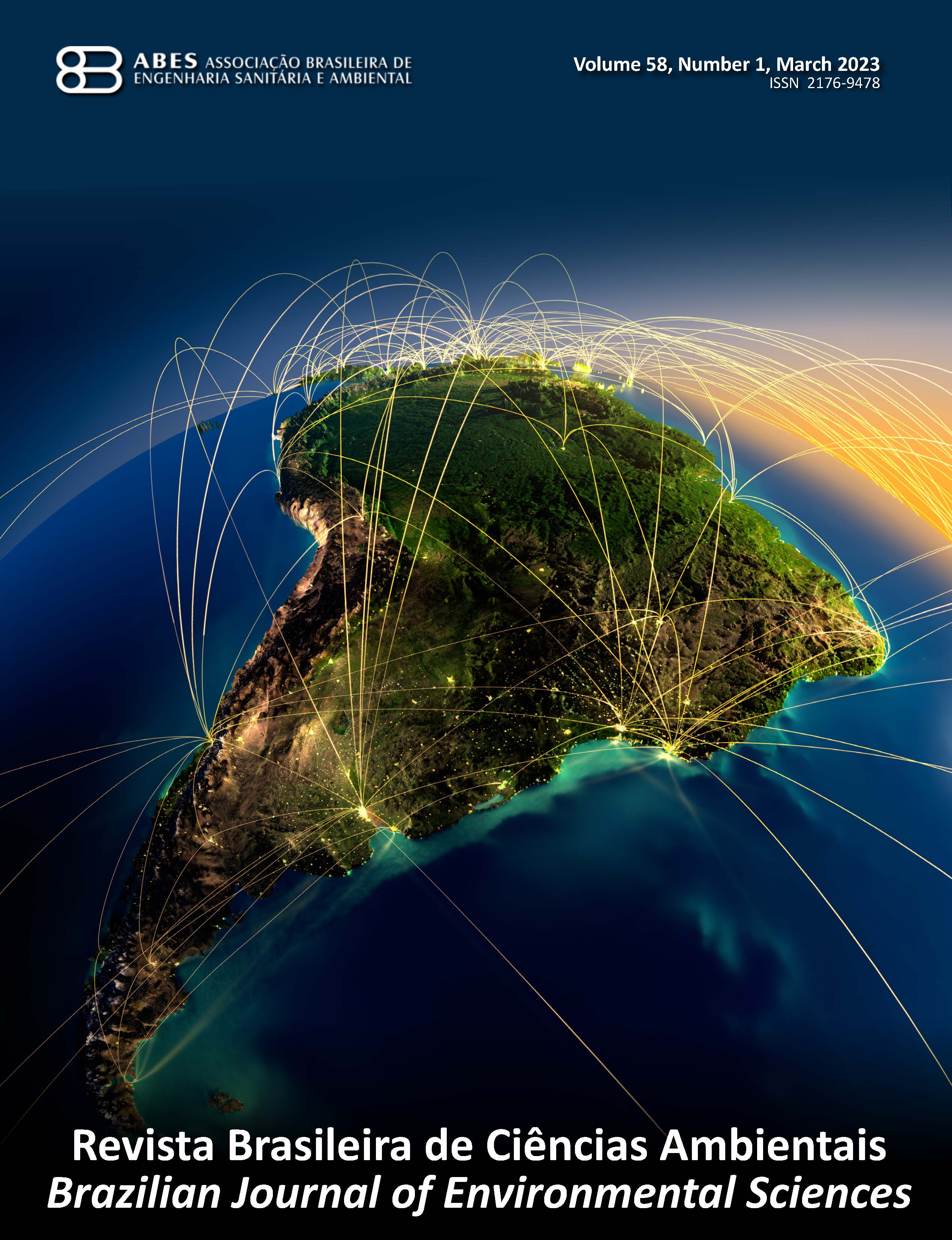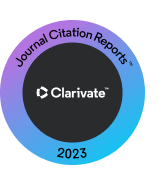Application of a convolutional neural network for automated multiclass identification of field-collected microplastics and diatom algae from optical microscopy images
DOI:
https://doi.org/10.5327/Z2176-94782491Keywords:
deep learning; microalgae; freshwater; plastics.Abstract
Microplastics are present all around the globe, and they are a major threat to the environment because of the challenges they pose. Their sampling, isolation, and analysis processes are laborious and difficult due to their size, shape, and spreading dynamics. Furthermore, the lack of standardized protocols in microplastic research makes it difficult to compare results and unify the progress of the field. In this context, this work proposes and evaluates a model architecture based on deep learning to classify microplastic images using a dataset of real microplastics sampled from a freshwater reservoir, with convolutional neural network and transfer learning. Moreover, the model identifies diatom algae frustules, which can persist in the hydrogen peroxide degradation during the process of microplastic isolation due to their biosilica composition. The model was developed in Python using the Google Colab environment. A total of 1,140 images were used, and to ensure a robust and generalized evaluation, 5-fold cross-validation was applied. The model achieved 93% accuracy, with a recall of 97, 95, 92, and 90% for algae, microplastic filaments, fragments, and pellets, respectively. Overall, the accuracy of the model is encouraging considering the dataset size and all the challenges that involve the automatic identification of microplastics, with all their shape variations and nuances; thus the results are promising. To our knowledge, this is the first work addressing diatom presence after one of the most common microplastic isolation techniques and their automated classification among microplastics as well.
Downloads
References
Annable, C., 2024. Python machine learning: a step-by-step journey with scikit-learn and tensor flow for beginners.
Ansari, H., 2024. Mastering tensorflow: unleashing the power of deep learning: a hands-on guide to building neural networks, image processing, and natural language understanding with tensorflow (Accessed August 14, 2025) at:. https://sciarium.com/file/632232/
Barsanti, L.; Gualtieri, P., 2023. Algae: anatomy, biochemistry, and biotechnology, Third edition. CRC Press, Boca Raton. https://doi.org/10.1201/9781003187707
Benson, N.U.; Agboola, O.D.; Fred-Ahmadu, O.H.; De-La-Torre, G.E.; Oluwalana, A.; Williams, A.B., 2022. Micro(nano)plastics prevalence, food web interactions, and toxicity assessment in aquatic organisms: a review. Frontiers in Marine Science, v. 9, 851281. https://doi.org/10.3389/fmars.2022.851281
Bostan, N.; Ilyas, N.; Akhtar, N.; Mehmood, S.; Saman, R.U.; Sayyed, R.Z.; Shatid, A.A.; Alfaifi, M.Y.; Elbehairi, S.E.I.; Pandiaraj, S., 2023. Toxicity assessment of microplastic (MPs). Environmental Research, v. 234, 116523. https://doi.org/10.1016/j.envres.2023.116523
California State Policy Evidence Consortium (CalSPEC), 2023. Microplastics occurrence, health effects, and mitigation policies: an evidence review for the California state legislature. CalSPEC, United States of America.
Castro, D.G.D.; Silva, A.L.L.D.; Lopes, M.D.N.; Freire, A.S.; Leite, N.K., 2024. Effect of urbanization and water quality on microplastic distribution in Conceição Lagoon watershed, Brazil. Environmental Science and Pollution Research, 31, 28870-28889. https://doi.org/10.1007/s11356-024-33029-y
Chollet, F., 2018. Deep learning with python. Manning Publications Co., Shelter Island.
Citterich, F.; Giudice, A.L.; Azzaro, M., 2023. A plastic world: A review of microplastic pollution in the freshwaters of the Earth's poles. Science of The Total Environment, v. 869, 161847. https://doi.org/10.1016/j.scitotenv.2023.161847
Corcoran, P.L.; Belontz, S.L.; Ryan, K.; Walzak, M.J., 2019. Factors controlling the distribution of microplastic particles in benthic sediment of the Thames River, Canada. Environmental Science & Technology, v. 54 (2), 818-825. https://doi.org/10.1021/acs.est.9b04896
Costa, J.P.; Duarte, A.C., 2022. Introduction to the analytical methodologies for the analysis of microplastics. In: Rocha-Santos, T.AP., Costa, M.F.; Mouneyrac, C. (Eds.), Handbook of microplastics in the environment. Springer, Cham. https://doi.org/10.1007/978-3-030-39041-9_1
Drabinski, T.L.; Carvalho, D.G.D.; Gaylarde, C.C.; Lourenço, M.F.P.; Machado, W.T.V.; Fonseca, E.M.; Silva, A.L.C.D.; Baptista Neto, J.A., 2023. Microplastics in freshwater river in Rio de Janeiro and its role as a source of microplastic pollution in Guanabara Bay, SE Brazil. Micro, v. 3 (1), 208-223. https://doi.org/10.3390/micro3010015
Duan, L.; Luo, L.; Zhang, L.; Li, D.; Li, H.; Xu, T.; Xu, J.; Zhang, H., 2024. The occurrence of microplastics pollution in the surface water and sediment of Lake Chenghai in Southwestern China. Water, v. 16 (18), 2672. https://doi.org/10.3390/w16182672
Egessa, R.; Nankabirwa, A.; Ocaya, H.; Pabire, W.G., 2020. Microplastic pollution in surface water of Lake Victoria. Science of the Total Environment, v. 741, 140201. https://doi.org/10.1016/j.scitotenv.2020.140201
Gerolin, C.R.; Pupim, F.N.; Sawakuchi, A.O.; Grohmann, C.H.; Labuto, G.; Semensatto, D., 2020. Microplastics in sediments from Amazon rivers, Brazil. Science of the Total Environment, v. 749, 141604. https://doi.org/10.1016/j.scitotenv.2020.141604
Giardino, M.; Balestra, V.; Janner, D.; Bellopede, R., 2023. Automated method for routine microplastic detection and quantification. Science of The Total Environment, vol. 859 (Part 2), 160036. https://doi.org/10.1016/j.scitotenv.2022.160036
Gosh, T.; Math, S.K.B., 2023. Practical mathematics for AI and deep learning. BPB Publications, India.
Hasnine, M.D.T.; Anik, A.H.; Alam, M.; Yuan, Q., 2024. Navigating microplastic challenges: separation and detection strategies in wastewater treatment. In: Kumar, A.; Singh, V. (Eds.), Microplastics pollution and its remediation. Springer, Cham.
He, D.; Luo, Y., 2020. Microplastics in terrestrial environments emerging contaminants and major challenges. In: Barceló, D.; Kostianoy, A.G. (Eds.), The handbook of environmental chemistry (Vol. 95). Springer, Cham. https://doi.org/10.1007/978-3-030-56271-7
Ivanic, F.M.; Guggenberger, G.; Woche, S.K.; Bachmann, J.; Hoppe, M.; Carstens, J.F., 2023. Soil organic matter facilitates the transport of microplastic by reducing surface hydrophobicity. Colloids and Surfaces A: Physicochemical and Engineering Aspects, v. 676 (Part B), 132255. https://doi.org/10.1016/j.colsurfa.2023.132255
Kurki-Fox, J.J.; Doll, B.A.; Monteleone, B.; West, K.; Putnam, G.; Kelleher, L.; Krause, S.; Schneidewind, U., 2023. Microplastic distribution and characteristics across a large river basin: Insights from the Neuse River in North Carolina, USA. Science of the Total Environment, 878, 162940. https://doi.org/10.1016/j.scitotenv.2023.162940
Kutralam-Muniasamy, G.; Pérez-Guevara, F.; Elizalde-Martínez, I.; Shruti, V.C., 2021. How well-protected are protected areas from anthropogenic microplastic contamination? Trends in Environmental Analytical Chemistry, (32), e00147. https://doi.org/10.1016/j.teac.2021.e00147
Lee, S.; Jeong, H.; Hong, S.M.; Yun, D.; Lee, J.; Kim, E.; Cho, K.H., 2023. Automatic classification of microplastics and natural organic matter mixtures using a deep learning model. Water Research, v. 246, 120710. https://doi.org/10.1016/j.watres.2023.120710
Lemos, C.F.; Fiori, A.P.; Oka-Fiori, C.; Tomazoni, J.C., 2014. Assoreamento da represa de Alagados pela contribuição de sedimentos da bacia hidrográfica do alto curso do rio Pitangui/PR. Geociências, v. 33 (4), 549-557 (Accessed August 14, 2025) at:. https://www.periodicos.rc.biblioteca.unesp.br/index.php/geociencias/article/view/9501
Li, J.; Zhang, J.; Ren, S.; Huang, D.; Liu, F.; Li, Z; Zhang, H.; Zhao, M.; Cao, Y.; Mofolo, S.; Liang, J.; Xu, W.; Jones, D.L.; Chadwick, D.R.; Liu, X.; Wang, K., 2023. Atmospheric deposition of microplastics in a rural region of North China Plain. Science of the Total Environment, v. 877, 162947. https://doi.org/10.1016/j.scitotenv.2023.162947
Li, X.; Bao, L.; Wei, Y.; Zhao, W.; Wang, F.; Liu, X.; Su, H.; Zhang, R., 2023. Occurrence, bioaccumulation, and risk assessment of microplastics in the aquatic environment: a review. Water, 15 (9), 1768. https://doi.org/10.3390/w15091768
Lorenzo-Navarro, J.; Castrillón-Santana, M.; Sánchez-Nielsen, E.; Zarco, B.; Herrera, A.; Martínez, I.; Gómez, M., 2021. Deep learning approach for automatic microplastics counting and classification. Science of the Total Environment, v. 765, 142728. https://doi.org/10.1016/j.scitotenv.2020.142728
Lucas-Solis, O.; Moulatlet, G.M.; Guamangallo, J.; Yacelga, N.; Villegas, L.; Galarza, E.; Rosero, B.; Zurita, B.; Sabando, L.; Cabrera, M.; Gimiliani, G.T.; Capparelli, M.V., 2021. Preliminary assessment of plastic litter and microplastic contamination in freshwater depositional areas: The case study of Puerto Misahualli, Ecuadorian Amazonia. Bulletin of Environmental Contamination and Toxicology, v. 107, 45-51. https://doi.org/10.1007/s00128-021-03138-2
Lv, L.; Yan, X.; Feng, L.; Jiang, S.; Lu, Z.; Xie, H.; Sun, S.; Chen, J.; Li, C., 2021. Challenge for the detection of microplastics in the environment. Water Environment Research, v. 93 (1), 5-15. https://doi.org/10.1002/wer.1281
Masura, J.; Baker, J.; Foster, G.; Arthur, C.; Herring, C., 2015. Laboratory methods for the analysis of microplastics in the marine environment. Silver Spring, United States (Accessed August 14, 2025) at:. https://repository.library.noaa.gov/view/noaa/10296
Mathew, J.T.; Inobeme, A.; Adetuyi, B.O.; Falana, Y.O.; Adetunji, C.O.; Shahnawaz, M., 2024. Application of microplastics in toiletry products. In: Shahnawaz, M.; Adetunji, C.O.; Dar, M.A.; Zhu, D. (Eds.), Microplastic pollution. Springer, Singapore. https://doi.org/10.1007/978-981-99-8357-5_5
Mathworks. Resnet50. Website (Accessed November 15, 2024) at:. https://www.mathworks.com/help/de eplearning/ref/resnet50.html
Mitchell, C.; Waterhouse, J., 2023. Microplastics in Arctic Sea ice: a petromodern archive fever. In: Konrad, T. (Ed.), Plastics, environment, culture, and the politics of waste. Edinburgh University Press, Edinburgh. https://doi.org/10.3366/edinburgh/9781399511735.003.0006
Nan, B.; Su, L.; Kellar, C.; Craig, N.J.; Keough, M.J.; Pettigrove, V., 2020. Identification of microplastics in surface water and Australian freshwater shrimp Paratya australiensis in Victoria, Australia. Environmental Pollution, v. 259, 113865. https://doi.org/10.1016/j.envpol.2019.113865
Nayeri, D.; Mousavi, S. A.; Almasi, A.; Asadi, A., 2023. Microplastic abundance, distribution, and characterization in freshwater sediments in Iran: a case study in Kermanshah city. Environmental Science and Pollution Research, v. 30 (17), 49817-49828. https://doi.org/10.1007/s11356-023-25620-6
Nielsen, M. Neural networks and deep learning (Accessed November 11, 2024) at:. http://neuralnetworksanddeeplearning.com/index.html
Parvin, F.; Hassan, A.; Tareq, S.M., 2022. Risk assessment of microplastic pollution in urban lakes and peripheral Rivers of Dhaka, Bangladesh. Journal of Hazardous Materials Advances, v. 8, 100187. https://doi.org/10.1016/j.hazadv.2022.100187
Ragusa, A.; Notarstefano, V.; Svelato, A.; Belloni, A.; Gioacchini, G.; Blondeel, C.; Zucchelli, E.; De Luca, C.; D’Avino, S.; Gulotta, A.; Carnevali, O.; Giorgini, E., 2022. Raman microspectroscopy detection and characterisation of microplastics in human breastmilk. Polymers, v. 14 (13), 2700. https://doi.org/10.3390/polym14132700
Saad, D.; Ramaremisa, G.; Ndlovu, M.; Chauke, P.; Nikiema, J.; Chimuka, L., 2024. Microplastic abundance and sources in surface water samples of the Vaal River, South Africa. Bulletin of Environmental Contamination and Toxicology, v. 112 (1), 23. https://doi.org/10.1007/s00128-023-03845-y
Sharifani, K.; Amini, M., 2013. Machine learning and deep learning: a review of methods and applications. World Information Technology and Engineering Journal, v. 10 (7), 3897-3904 (Accessed August 14, 2025) at:. https://ssrn.com/abstract=4458723
Shi, B.; Patel, M.; Yu, D.; Yan, J.; Li, Z.; Petriw, D.; Pruyn, T.; Smyth, K.; Passeport, E.; Miller, R.J.D.; Howe, J.Y., 2022. Automatic quantification and classification of microplastics in scanning electron micrographs via deep learning. Science of the Total Environment, v. 825, 153903. https://doi.org/10.1016/j.scitotenv.2022.153903
Strady, E.; Dang, T.H.; Dao, T.D.; Dinh, H.N.; Do, T.T.D.; Duong, T.N.; Duong, T.T.; Hoang, D.A.; Kieu-Le, T.C.; Le, T.P.Q.; Mai, H.; Trinh, D.M.; Nguyen, Q.H; Tran-Nguyen, Q.A.; Tran, Q.V.; Truong, T.N.S.; Chu, V.H.; Vo, V.C., 2021. Baseline assessment of microplastic concentrations in marine and freshwater environments of a developing Southeast Asian country, Viet Nam. Marine Pollution Bulletin, v. 162, 111870. https://doi.org/10.1016/j.marpolbul.2020.111870
Sun, X.; Zhang, M.; Liu, J.; Hui, G.; Chen, X.; Feng, C., 2024. The art of exploring diatom biosilica biomaterials: from biofabrication perspective. Advanced Science, v. 11 (6), 2304695. https://doi.org/10.1002/advs.202304695
Tang, Y.; Liu, Y.; Chen, Y.; Zhang, W.; Zhao, J.; He, S.; Yang, C.; Zhang, T.; Tang, C.; Zhang, C.; Yang, Z., 2020. A review: Research progress on microplastic pollutants in aquatic environments. Science of the Total Environment, v. 766, 142572. https://doi.org/10.1016/j.scitotenv.2020.142572
TESCAN Group. TESCAN MIRA (Accessed September 13, 2024) at:. https://www.tescan.com/pt-br/product/sem-for-materials-science-tescan-mira/
Vidal, A.; Phuong, N.N.; Métais, I.; Gasperi, J.; Châtel, A., 2023. Assessment of microplastic contamination in the Loire River (France) throughout analysis of different biotic and abiotic freshwater matrices. Environmental Pollution, v. 334, 122167. https://doi.org/10.1016/j.envpol.2023.122167
Vithanage, M.; Prasad, M.N.V. (Eds.), 2023. Microplastics in the ecosphere: air, water, soil, and food. John Wiley & Sons, Hoboken.
Wang, C.; O'Connor, D.; Wang, L.; Wu, W.M.; Luo, J.; Hou, D., 2022. Microplastics in urban runoff: Global occurrence and fate. Water Research, v. 225, 119129. https://doi.org/10.1016/j.watres.2022.119129
Zhang, A.; Lipton, Z. C.; Li, M.; Smola, A.J., 2023. Dive into deep learning. Cambridge University Press, Cambridge.
Downloads
Published
How to Cite
Issue
Section
License
Copyright (c) 2025 Revista Brasileira de Ciências Ambientais

This work is licensed under a Creative Commons Attribution 4.0 International License.

























